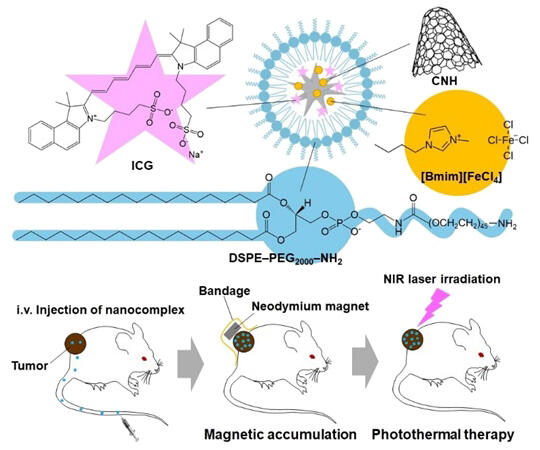A research group led by Professor Eijiro Miyako from the Materials Chemistry Frontier Research Area at the Japan Advanced Institute of Science and Technology (JAIST) has announced the successful development of magnetically and optically controllable nanoparticles. They confirmed in mice that these particles can accumulate in tumors, exert anti-cancer effects, and enable cancer treatment through visualization and photothermal conversion. The nanoparticles, which involve coating carbon nanohorns (CNH) with magnetic ionic liquid, near-infrared fluorescent dye, and a dispersant, were also found to have extremely minimal adverse effects on living organisms. This breakthrough is expected to lead to new cancer diagnosis and treatment technologies. The group's findings were published in the international academic journal Small Science on March 3.

Image Credit: Eijiro Miyako from JAIST
Ionic liquids are salts that exist as liquids at room temperature with characteristics such as low melting points, low volatility, high ionic concentrations, and high ionic conductivity. They have been applied to various industrial uses, such as electrolytes for capacitors. In recent years, ionic liquids have been found to have anti-cancer properties. They consist of extremely simple components—cationic and anionic molecules—and magnetic ionic liquids that respond to magnetic fields are particularly stable, non-volatile, and non-flammable. CNHs are a type of carbon nanotube that form spherical aggregates approximately 100 nm in diameter as irregular shapes cluster together, and they have high biocompatibility.
Miyako and his team previously discovered that CNHs easily generate heat when exposed to laser light in the highly tissue-penetrating wavelength range (650-1100 nm). They have been working to enhance CNH performance while developing cancer diagnosis and treatment technologies that utilize this photothermal property.
In this study, they developed novel nanoparticles combining magnetic ionic liquid ([Bmin][FeCl4]) with photothermal material (CNH) and investigated their application as cancer diagnosis and treatment technology. The developed nanoparticles demonstrated particle size stability for over 7 days, high cell permeability with anti-cancer effects, and confirmed heat generation upon near-infrared laser irradiation.
Next, the nanoparticles were administered through the tail vein to mice with transplanted colon cancer (about 10 days after transplantation). A small neodymium magnet was attached to the affected area for 24 hours, followed by near-infrared light irradiation at 740-790 nm.
The results confirmed that in addition to the EPR effect characteristic of nanoparticles, these particles were more effectively incorporated into cancer tissue compared with cases without neodymium magnets or without magnetic ionic liquid coating. Furthermore, when 808 nm near-infrared laser light was irradiated to the affected area where the nanoparticles had accumulated, complete cancer disappearance was achieved after 5 days due to not only the anti-cancer effect of [Bmin][FeCl4] but also the photothermal conversion effect of CNH.
Histological evaluation of the efficacy mechanism within the tumor revealed that significant destruction of cancer cell tissues occurred, especially with nanoparticles subjected to magnetic field application and laser irradiation. Biocompatibility evaluated through histological examination, blood tests, and body weight measurement showed that the impact on living organisms was extremely minimal.
Miyako commented: "With an eye toward future clinical applications, we are currently planning safety tests of these nanoparticles using large animals. We hope to conduct clinical trials within 10 years."
Journal Information
Publication: Small Science
Title: Multifunctional Magnetic Ionic Liquid-Carbon Nanohorn Complexes for Targeted Cancer Theranostics
DOI: 10.1002/smsc.202400640
This article has been translated by JST with permission from The Science News Ltd. (https://sci-news.co.jp/). Unauthorized reproduction of the article and photographs is prohibited.




